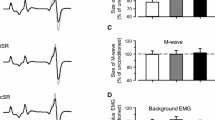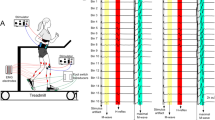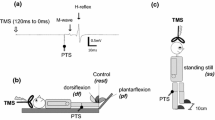Abstract
Human withdrawal-reflex receptive fields were assessed in 10 healthy subjects during standing with even support on both legs. Two electrical-stimulus intensities (1.2 and 2.2 times the pain threshold, PTh) were used. The painful stimuli were delivered in random order to 12 positions distributed over the foot sole. Tibialis anterior (TA), soleus (SO), vastus lateralis (VL), semitendinosus (ST), and iliopsoas (IL) reflexes were recorded. Further, the vertical force was recorded and the center or pressure (CoP) was assessed in the frontal and sagittal planes on both legs. Reflexes were observed at both intensities with the strongest reflexes at the high intensity. Around the ankle joint, SO reflexes dominated, which is in contrast to previous observations for subjects sitting. An unloading of the limb was found on the stimulated leg associated with a simultaneous loading of the contralateral leg. The shift in load was most pronounced for stimulation of the heel. The flexors ST and IL also had strong reflexes with reflex patterns correlated to the pattern of unloading. The shift in vertical force was accomplished by a move of the CoP in the anterior direction on the stimulated limb (contraction of SO), which simultaneously caused a small movement of the CoP in the lateral direction. In the present standing conditions, the ankle extensor played a dominant role in the withdrawal pattern in contrast to previous studies during sitting, relaxed conditions.





Similar content being viewed by others
References
Andersen OK, Jensen LM, Brennum J, Arendt-Nielsen L (1995) Modulation of the human nociceptive reflex by cyclic movements. Eur J Appl Physiol 70:311–321
Andersen OK, Sonnenborg FA, Arendt-Nielsen L (1999) Modular organization of human leg withdrawal reflexes elicited by electrical stimulation of the foot sole. Muscle Nerve 22:1520–1530
Andersen OK, Sonnenborg FA, Arendt-Nielsen L (2001) Reflex receptive fields for human withdrawal reflexes elicited by nonpainful and painful electrical stimulation of the foot sole. Clin Neurophysiol 112:641–649
Bent LR, Potvin JR, Brooke JD, McIlroy WE (2001) Medio-lateral balance adjustments preceding reflexive limb withdrawal are modified by postural demands. Brain Res 914:100–105
Burke D, Dickson HG, Skuse NF (1991) Task-dependent changes in the responses to low-threshold cutaneous afferents in the human lower limb. J Physiol (Lond) 432:445–458
Clarke RW, Ford TW, Taylor JS (1989) Reflex actions of selective stimulation of sural nerve C fibres in the rabbit. Q J Exp Physiol 74:681–690
Crenna P, Frigo C (1984) Evidence of phase-dependent nociceptive reflexes during locomotion in man. Exp Neurol 85:336–345
Decchi B, Zalaffi A, Spidalieri R, Arrigucci U, Di TA, Rossi A (1997) Spinal reflex pattern to foot nociceptive stimulation in standing humans. Electroencephalogr Clin Neurophysiol 105:484–489
Duysens J, Trippel M, Hortsmann GA, Dietz V (1990) Gating and reversal of reflexes in ankle muscles during human walking. Exp Brain Res 82:351–358
Duysens J, Tax AAM, Trippel M, Dietz V (1993) Increased amplitude of cutaneous reflexes during human running as compared to standing. Brain Res 613:230–238
Gracely RH (1994) Studies of pain in normal man. In: Melzack R, Wall PD (eds) Textbook of pain. Churchill Livingstone, London, pp 315–336
Grimby L (1963) Normal plantar response: Integration of flexor and extensor reflex components. J Neurol Neurosurg Psychiatry 26:39–50
Hagbarth KE (1952) Excitatory and inhibitory skin areas for flexor and extensor motoneurones (abstract). Acta Physiol Scand (Suppl 94) 26:1.58
Hagbarth KE (1960) Spinal withdrawal reflexes in human lower limbs. J Neurol Neurosurg Psychiatry 23:222–227
Hagbarth KE, Finer B (1963) The plasticity of human withdrawal reflexes to noxious skin stimuli in lower limbs. Prog Brain Res 1:65–78
Komiyama T, Zehr EP, Stein RB (2000) Absence of nerve specificity in human cutaneous reflexes during standing. Exp Brain Res 133:267–272
Kugelberg E, Eklund K, Grimby L (1960) An electromyographic study of the nociceptive reflexes of the lower limb. Mechanism of the plantar responses. Brain 83:394–410
Levinsson A, Garwicz M, Schouenborg J (1999) Sensorimotor transformation in cat nociceptive withdrawal reflex system. Eur J Neurosci 11:4327–4332
McIlroy WE, Bent LR, Potvin JR, Brooke JD, Maki BE (1999) Preparatory balance adjustments precede withdrawal response to noxious stimulation in standing humans. Neurosci Lett 267:197–200
Meinck HM, Piesiur-Strehlow B, Koehler W (1981) Some principles of flexor reflex generation in human leg muscles. Electroencephalogr Clin Neurophysiol 52:140–150
Meinck H-M, Küster S, Benecke R, Conrad B (1985) The flexor reflex—influence of stimulus parameters on the reflex response. Electroencephalogr Clin Neurophysiol 61:287–298
Paquet N, Tam F, Hui-Chan CW (1996) Functional modulation of the human flexion and crossed extension reflexes by body position. Neurosci Lett 209:215–217
Rietdyk S, Patla AE (1998) Context-dependent reflex control: some insights into the role of balance. Exp Brain Res 119:251–259
Rossi A, Decchi B (1994) Flexibility of lower limb reflex responses to painful cutaneous stimulation in standing humans: evidence of load-dependent modulation. J Physiol (Lond) 481:521–532
Schomburg ED (1990) Spinal sensorimotor system and their supraspinal control. Neurosci Res 7:265–340
Schouenborg J, Kalliomäki J (1990) Functional organization of the nociceptive withdrawal reflexes. I. Activation of hind limb muscles in the rat. Exp Brain Res 83:67–78
Sherrington CS (1910) Flexion-reflex of the limb, crossed extension-reflex and reflex stepping and standing. J Physiol (Lond) 40:28–121
Sonnenborg FA, Andersen OK, Arendt-Nielsen L (2000) Modular organization of excitatory and inhibitory reflex receptive fields elicited by electrical stimulation of the foot sole in man. Clin Neurophysiol 111:2160–2169
Sonnenborg FA, Andersen OK, Arendt-Nielsen L, Treede R-D (2001) Withdrawal reflex organization to electrical stimulation of the dorsal foot in humans. Exp Brain Res 136:303–312
Van Wezel BM, Ottenhoff FA, Duysens J (1997) Dynamic control of location-specific information in tactile cutaneous reflexes from the foot during human walking. J Neurosci 17:3804–3814
Willer JC (1977) Comparative study of perceived pain and nociceptive flexion reflex in man. Pain 3:69–80
Winter DA (1979) Biomechanics of human movement. Wiley, New York
Zehr EP, Stein RB (1999) What functions do reflexes serve during human locomotion? Prog Neurobiol 58:185–205
Acknowledgements
This study was supported by The Danish Technical Research Council.
Author information
Authors and Affiliations
Corresponding author
Rights and permissions
About this article
Cite this article
Andersen, O.K., Sonnenborg, F., Matjačić, Z. et al. Foot-sole reflex receptive fields for human withdrawal reflexes in symmetrical standing position. Exp Brain Res 152, 434–443 (2003). https://doi.org/10.1007/s00221-003-1550-1
Received:
Accepted:
Published:
Issue Date:
DOI: https://doi.org/10.1007/s00221-003-1550-1




